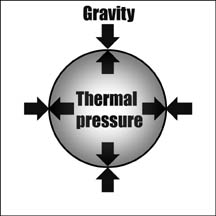What is Your Cosmic Connection to the Elements?
As the Universe continued to expand and cool, the atoms formed in the Big Bang coalesced into large clouds of gas. These clouds were the only matter in the Universe for millions of years before the planets and stars formed. Then, about 200 million years after the Big Bang, the first stars began to shine and the creation of new elements began.
 |
| Figure 2: In a star, outward thermal pressure exactly matches the inward pull of gravity. |
Stars form when the giant clouds of gas, light-years across and consisting mostly of hydrogen, begin to contract under their own gravity. First, clumps of denser hydrogen gas form, which over millions of years eventually combine to form a giant ball of gas hundreds of thousands of times more massive than the Earth. The gas ball contracts under its own gravity, creating enormous pressure at the center. The increase in pressure causes an increase in temperature at the star's center. It becomes so hot that the electrons are stripped from the atoms. What's left are hydrogen nuclei, moving faster and faster as the ball of gas contracts and the temperature at the center continues to increase. Once the temperature reaches 15 million Kelvin, the hydrogen nuclei are moving so fast that when they collide they fuse together. This releases a great deal of energy. The energy from this nuclear fusion pours out from the center of the ball of gas and counteracts gravity's relentless inward pull. The ball of gas is now stable, with the inward pull of gravity exactly balanced by the outward pressure from the exploding fusion energy in the core. This energy flows out through the star, and when it reaches the surface, it radiates off into space. The ball of gas begins to shine as a new star.
Stars come in a variety of sizes, anywhere from one-tenth to sixty (or more) times the mass of our Sun. At their hearts, all normal stars are fueled by the energy of nuclear fusion. Depending on the size of the star, however, different elements are created in the fusion process.




